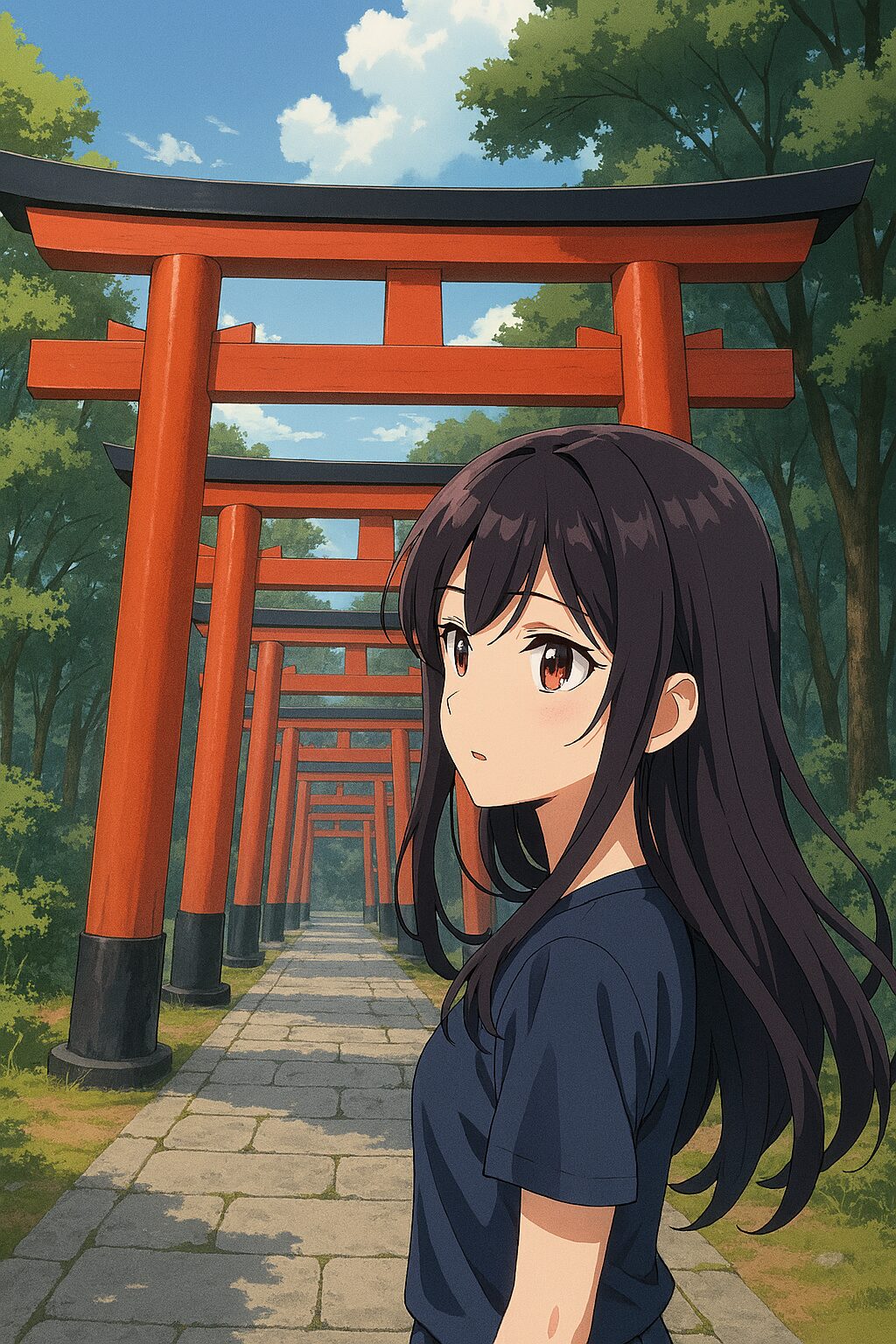- Introduction: A Simple Question with Profound Meaning
- 🏯 What Is a Torii Gate?
- 🔴 The Meaning of Red: Protection and Vitality
- 🧭 A Brief History of Vermilion Torii
- 🌌 The Experience of Passing Through a Red Gate
- 🧘♀️ Red and the Japanese Aesthetic of “Ma”
- 🛕 Shrines vs. Temples: A Colorful Distinction
- 🗺️ Where to See Red Torii Gates in Japan
- ✨ Conclusion: Red as a Gateway to Reverence
- はじめに:赤い鳥居に込められた“問い”
- 🏯 鳥居とは何か?―神と人の境界線
- 🔴 赤の意味:魔除けと生命力の象徴
- 🧭 歴史の中の赤い鳥居
- 🌌 赤い鳥居をくぐるという体験
- 🧘♀️ 色彩と感性:赤がもたらす“間”の美
- 🛕 神社と寺の違いにも注目
- 🗺️ 赤い鳥居を訪ねて:おすすめスポット
- ✨ まとめ:赤に込められた祈りと感性
Introduction: A Simple Question with Profound Meaning
If you’ve ever visited Japan—or even just browsed photos of its shrines—you’ve likely seen them: striking red gates standing tall at the entrance to sacred spaces. These are torii gates, and they mark the boundary between the everyday world and the divine.
But have you ever wondered: Why are torii gates red?
This question, seemingly simple, opens the door to a rich tapestry of cultural, spiritual, and aesthetic meanings. In this article, we’ll explore the origins of the torii’s iconic color, its symbolic power, and the emotional experience of walking through one.
🏯 What Is a Torii Gate?
A torii is more than just a gate—it’s a threshold. It marks the entrance to a Shinto shrine, separating the secular world from the sacred. Passing through a torii is a symbolic act: a quiet transition from the noise of daily life to a space of reverence and reflection.
🔴 The Meaning of Red: Protection and Vitality
Red as a Protective Color
In Japanese tradition, red has long been associated with warding off evil. Influenced by Chinese cosmology, red represents fire—an element believed to purify and protect. Painting torii gates red was a way to shield the sacred space from malevolent forces.
Red as a Symbol of Life
Red also symbolizes life and vitality. The particular shade used on torii gates—known as vermilion or shu-iro—was traditionally made from cinnabar, a pigment containing mercury. This not only gave the gates their vivid hue but also helped preserve the wood from decay.
In this way, the color red serves both a spiritual and practical purpose.
🧭 A Brief History of Vermilion Torii
Torii gates have existed since at least the Nara period (8th century), but it was during the Heian period that vermilion became the standard color. One of the most iconic examples is Fushimi Inari Taisha in Kyoto, where thousands of red torii form a mesmerizing tunnel through the forested hillside.
👉 Fushimi Inari Taisha: Why the World Is Obsessed with Japan’s Most Visited Shrine
🌌 The Experience of Passing Through a Red Gate
Walking through a torii gate is more than a physical act—it’s a psychological shift. The vivid red color draws your attention, sharpens your senses, and prepares your mind for prayer or contemplation.
It’s as if the color itself whispers: “You are entering a different realm. Be still. Be present.”
🧘♀️ Red and the Japanese Aesthetic of “Ma”
In Japanese aesthetics, ma refers to the space between things—a pause, a silence, an interval. Red torii gates create ma by standing in contrast to their surroundings: the green of trees, the blue of sky, the gray of stone.
This contrast heightens awareness and invites introspection. The gate doesn’t just mark a boundary—it creates a moment.
🛕 Shrines vs. Temples: A Colorful Distinction
It’s worth noting that only Shinto shrines have torii gates. Buddhist temples, by contrast, feature sanmon gates and rarely use red in the same way.
👉 Shrines vs. Temples in Japan: What’s the Difference?
Understanding this distinction helps deepen your appreciation of Japan’s spiritual landscape.
🗺️ Where to See Red Torii Gates in Japan
If you want to experience the power of red torii gates firsthand, here are a few must-visit spots:
- Fushimi Inari Taisha (Kyoto)
- Nezu Shrine (Tokyo)
- Usa Jingu (Oita)
- Itsukushima Shrine (Hiroshima)
Each offers a unique atmosphere, shaped by local traditions and natural surroundings.
✨ Conclusion: Red as a Gateway to Reverence
The red of a torii gate is not just a color—it’s a message. It speaks of protection, vitality, transition, and presence. It invites us to pause, reflect, and enter a space where the sacred is near.
Next time you pass through a torii, take a breath. Let the red wash over you. You’re not just walking—you’re crossing into something deeper.
🟥 なぜ鳥居は赤いのか?―色彩に宿る祈りと境界の美学
はじめに:赤い鳥居に込められた“問い”
日本を旅する人なら誰もが一度は目にする、あの鮮やかな赤い鳥居。 神社の入り口に立つその姿は、まるで異世界への扉のように私たちを迎え入れます。
でも、ふと疑問に思いませんか? なぜ鳥居は赤いのでしょうか? それは単なる装飾ではなく、深い文化的・精神的意味が込められた色なのです。
この記事では、鳥居の赤に秘められた歴史、信仰、そして感性の物語を紐解いていきます。
🏯 鳥居とは何か?―神と人の境界線
まず、鳥居の役割を理解することから始めましょう。
鳥居は神社の入り口に立つ「門」のような存在ですが、単なる建築物ではありません。 それは、俗世と神域を分ける“境界”であり、神聖な空間への入り口です。
鳥居をくぐることで、私たちは日常から離れ、祈りと静寂の世界へと足を踏み入れるのです。
🔴 赤の意味:魔除けと生命力の象徴
では、なぜその境界が「赤」で彩られているのでしょうか?
赤は魔除けの色
日本では古来より、赤は邪気を払う力を持つ色とされてきました。 これは中国の陰陽五行思想の影響も受けており、赤=火=浄化の力と考えられていたのです。
神社の鳥居が赤いのは、神域を守るための魔除けの意味が込められているのです。
赤は生命の色
赤は血の色でもあり、生命力や再生の象徴でもあります。 神々の力が宿る場所にふさわしい色として、赤は選ばれてきました。
特に「朱色」と呼ばれる赤は、水銀を含む「丹(に)」という顔料から作られ、腐食防止の効果もありました。 つまり、実用性と信仰が融合した色なのです。
🧭 歴史の中の赤い鳥居
鳥居の起源には諸説ありますが、奈良時代にはすでに存在していたとされます。 平安時代以降、神社建築が整備される中で、朱塗りの鳥居が一般化していきました。
特に有名なのが、京都の伏見稲荷大社。 千本鳥居と呼ばれる朱色の鳥居が連なる光景は、まさに“赤の回廊”とも言える神秘的な空間です。
🌌 赤い鳥居をくぐるという体験
鳥居をくぐる瞬間、私たちは無意識に背筋を伸ばし、心を整えます。 それは、赤という色が持つ精神的な作用によるものかもしれません。
赤は視覚的に強く、私たちの注意を引きつけます。 それが神域への集中を促し、祈りの空間へと導いてくれるのです。
🧘♀️ 色彩と感性:赤がもたらす“間”の美
日本文化には「間(ま)」という概念があります。 それは空間の余白であり、時間の静けさでもあります。
赤い鳥居は、その「間」を際立たせる存在です。 周囲の緑や空の青と対比することで、色の“間”が生まれ、感性が研ぎ澄まされるのです。
🛕 神社と寺の違いにも注目
ちなみに、赤い鳥居があるのは神社だけです。 寺院には鳥居はなく、代わりに山門があります。
この違いは、神道と仏教という宗教的背景の違いに由来します。
🗺️ 赤い鳥居を訪ねて:おすすめスポット
以下の神社では、赤い鳥居の美しさとその意味を体感できます。
- 伏見稲荷大社(京都)
- 根津神社(東京)
- 宇佐神宮(大分)
- 厳島神社(広島)
それぞれの鳥居には、地域の信仰と美意識が宿っています。
✨ まとめ:赤に込められた祈りと感性
鳥居が赤い理由は、単なる色彩の選択ではありません。 それは、魔除けの力、生命の象徴、空間の美学、そして祈りの導線なのです。
赤い鳥居をくぐるとき、私たちは知らず知らずのうちに、 「神聖なものに触れる準備」をしているのかもしれません。



コメント